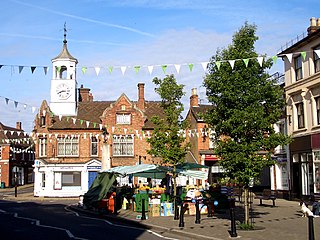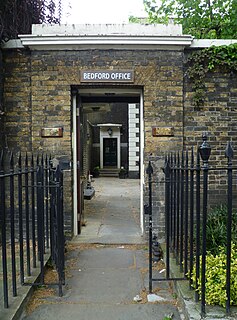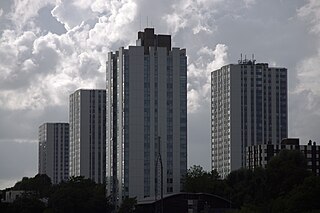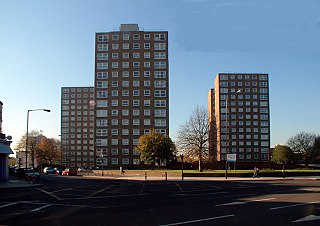
Euston Road is a road in Central London that runs from Marylebone Road to King's Cross. The route is part of the London Inner Ring Road and forms part of the London congestion charge zone boundary. It is named after Euston Hall, the family seat of the Dukes of Grafton, who had become major property owners in the area during the mid-19th century.
Somers Town is an inner-city district in North West London. It has been strongly influenced by the three mainline north London railway termini: Euston (1838), St Pancras (1868) and King's Cross (1852), together with the Midland Railway Somers Town Goods Depot (1887) next to St Pancras, where the British Library now stands.

Euston Tower is a skyscraper located on Euston Road in the London Borough of Camden. To its east is Hampstead Road.

Ampthill is a town and civil parish in Bedfordshire, England, between Bedford and Luton, with a population estimate of 8,100. It is administered by Ampthill Town Council. The ward of Ampthill which also includes Maulden and Clophill has an estimated population of 13,280 and is administered by Central Bedfordshire Council.

Tavistock Square is a public square in Bloomsbury, in the London Borough of Camden.

Camden Town Hall, known as St Pancras Town Hall until 1965, is the headquarters of Camden London Borough Council. The main entrance is in Judd street with its northern elevation extending along Euston Road, opposite the main front of St Pancras railway station. It has been Grade II listed since 1996.

Regent's Park Estate is a large housing estate in the London Borough of Camden. The estate consists of nearly 2,000 homes across 49 buildings and lies on either side of Robert Street, between Albany Street and Hampstead Road. It is immediately to the east of the Regent's Park estate owned by the Crown Estate. The estate includes the sites of Cumberland Market, Munster Square and Clarence Gardens.

The Bedford Estate is an estate in central London owned by the Russell family, which holds the peerage title of Duke of Bedford. The estate was originally based in Covent Garden, then stretched to include Bloomsbury in 1669. The Covent Garden property was sold for £2 million in 1913 by Herbrand Russell, 11th Duke of Bedford, to the MP and land speculator Harry Mallaby-Deeley, who sold his option to the Beecham family for £250,000; the sale was finalised in 1918.

Cladding is the application of one material over another to provide a skin or layer. In construction, cladding is used to provide a degree of thermal insulation and weather resistance, and to improve the appearance of buildings. Cladding can be made of any of a wide range of materials including wood, metal, brick, vinyl, and composite materials that can include aluminium, wood, blends of cement and recycled polystyrene, wheat/rice straw fibres. Rainscreen cladding is a form of weather cladding designed to protect against the elements, but also offers thermal insulation. The cladding does not itself need to be waterproof, merely a control element: it may serve only to direct water or wind safely away in order to control run-off and prevent its infiltration into the building structure. Cladding may also be a control element for noise, either entering or escaping. Cladding can become a fire risk by design or material.
The 1950s and 1960s saw the construction of numerous brutalist apartment blocks in Sheffield, England. The Sheffield City Council had been clearing inner-city residential slums since the early 1900s. Prior to the 1950s these slums were replaced with low-rise council housing, mostly constructed in new estates on the edge of the city. By the mid-1950s the establishment of a green belt had led to a shortage of available land on the edges of the city, whilst the government increased subsidies for the construction of high-rise apartment towers on former slum land, so the council began to construct high-rise inner city estates, adopting modernist designs and industrialised construction techniques, culminating in the construction of the award-winning Gleadless Valley and Park Hill estates.

On 14 June 2017, a high-rise fire broke out in the 24-storey Grenfell Tower block of flats in North Kensington, West London, at 00:54 BST; 72 people died, including two who later died in hospital. More than 70 others were injured and 223 people escaped. It was the deadliest structural fire in the United Kingdom since the 1988 Piper Alpha oil-platform disaster and the worst UK residential fire since World War II.

Grenfell Tower is a derelict 24-storey residential tower block in North Kensington in London, England. The tower was completed in 1974 as part of the first phase of the Lancaster West Estate. The tower was named after Grenfell Road, which ran to the south of the building; the road itself was named after Field Marshal Lord Grenfell, a senior British Army officer. Most of the tower was destroyed in a severe fire on 14 June 2017.

Lancaster Road (West) Estate is a housing estate in North Kensington, west London.

Tower blocks are high-rise buildings for residential use. These blocks began to be built in Great Britain after the Second World War. The first residential tower block, "The Lawn", was constructed in Harlow, Essex, in 1951; it is now a Grade II listed building. In many cases, tower blocks were seen as a "quick-fix" to cure problems caused by the existence of crumbling and unsanitary 19th-century dwellings or to replace buildings destroyed by German aerial bombing. It was argued that towers surrounded by public open space could provide for the same population density as the terraced housing and small private gardens they replaced, offering larger rooms and improved views, whilst being cheaper to build.

Chalcots Estate is a council housing estate on Adelaide Road and Fellows Road in Swiss Cottage in the London Borough of Camden. It was designed by Dennis Lennon and Partners. The Chalcots Estate was built on land owned by Eton College, which is reflected in the names of the individual buildings.

Rydon is a British construction company which was founded in 1978 and employs over 650 people. Its head office is in Forest Row, East Sussex, and it has offices in Bristol, Dartford, London and Preston.
Harley Facades is a British construction company that designs and installs external cladding on buildings.

The Ledbury Estate is a large estate of social housing, in Peckham in the London Borough of Southwark. The estate is just south of the Old Kent Road, part of the A2 4 kilometres (2.5 mi) from both Tower Bridge and the Elephant & Castle it is adjacent to land used by George Livesey for the South London Gasworks.

Fellows Road is a two-lane road in the London Borough of Camden, just north of Central London. It is on the Eton College estate, a series of roads and houses built to replace the area destroyed in World War II, on land owned by Eton College. The road was originally built in 1873 and finished between 1874 and 1894, and named after the college's fellows.

Hampstead Road is a road in London, England, stretching over a kilometre between Bloomsbury and Camden Town. It is signed as the A400. Hampstead Road terminates at Euston Road in the south, where it continues as Tottenham Court Road and Gower Street. In the north, at Mornington Crescent, Hampstead Road becomes Camden High Street.

















